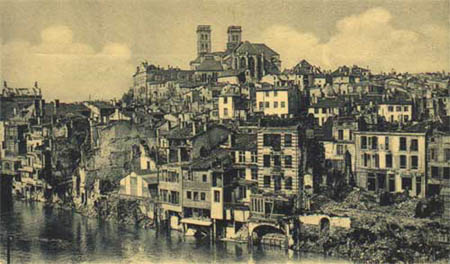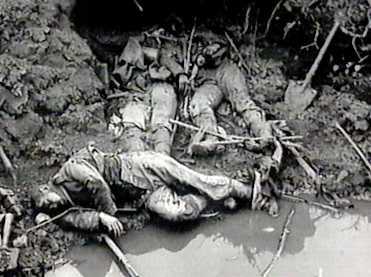Saturday, 12 February 2011
Wednesday, 9 February 2011
Tuesday, 8 February 2011
sharpsburg
these were my first ever conversions, i used a core figure of the great bmc series then cut the thing up to all i had left was the bayonet and a bit of the head. i used pattex filler.Below is Generale Mead's idea of the battle

First World war artillery at Verdun

The Battle of Verdun was one of the major battles during the First World War on the Western Front. It was fought between the German and French armies, from 21 February to 14 December 1916, on hilly terrain north of the city of Verdun-sur-Meuse, in north-eastern France.  As pointed out in 1996 by French historian Alain Denizot Verdun in his doctoral thesis "Verdun, 1914-1918", the Battle of Verdun ended as a French tactical victory. However, it can also be considered a costly strategic stalemate.
As pointed out in 1996 by French historian Alain Denizot Verdun in his doctoral thesis "Verdun, 1914-1918", the Battle of Verdun ended as a French tactical victory. However, it can also be considered a costly strategic stalemate. The German High Command failed to achieve its two objectives: 1) to capture the city of Verdun and 2) to inflict a much higher casualty count on its French adversary.
The German High Command failed to achieve its two objectives: 1) to capture the city of Verdun and 2) to inflict a much higher casualty count on its French adversary.  jon smith modelbrau
jon smith modelbrau
By the end of the battle the French Second Army had rolled back the German forces around Verdun, but not quite to their initial lines of February 1916.
 As pointed out in 1996 by French historian Alain Denizot Verdun in his doctoral thesis "Verdun, 1914-1918", the Battle of Verdun ended as a French tactical victory. However, it can also be considered a costly strategic stalemate.
As pointed out in 1996 by French historian Alain Denizot Verdun in his doctoral thesis "Verdun, 1914-1918", the Battle of Verdun ended as a French tactical victory. However, it can also be considered a costly strategic stalemate. The German High Command failed to achieve its two objectives: 1) to capture the city of Verdun and 2) to inflict a much higher casualty count on its French adversary.
The German High Command failed to achieve its two objectives: 1) to capture the city of Verdun and 2) to inflict a much higher casualty count on its French adversary.  jon smith modelbrau
jon smith modelbrauBy the end of the battle the French Second Army had rolled back the German forces around Verdun, but not quite to their initial lines of February 1916.

Verdun resulted in 307,700 battlefield deaths (143,000 163,000 French and German combatants) plus at least half a million wounded, an average of 30,000 deaths for each of the ten months of the battle. It was the longest and one of the most devastating battles in the First World War and the history of warfare. Verdun was primarily an artillery battle: a total of about 40 million artillery shells were exchanged, leaving behind millions of overlapping shell craters that are still partly visible. In both France and Germany, Verdun has come to represent the horrors of war, like the Battle of the Somme in the British consciousness. The renowned British military historian Major General Julian Thompson has referred to Verdun as "France's Stalingrad".
It was the longest and one of the most devastating battles in the First World War and the history of warfare. Verdun was primarily an artillery battle: a total of about 40 million artillery shells were exchanged, leaving behind millions of overlapping shell craters that are still partly visible. In both France and Germany, Verdun has come to represent the horrors of war, like the Battle of the Somme in the British consciousness. The renowned British military historian Major General Julian Thompson has referred to Verdun as "France's Stalingrad".
 It was the longest and one of the most devastating battles in the First World War and the history of warfare. Verdun was primarily an artillery battle: a total of about 40 million artillery shells were exchanged, leaving behind millions of overlapping shell craters that are still partly visible. In both France and Germany, Verdun has come to represent the horrors of war, like the Battle of the Somme in the British consciousness. The renowned British military historian Major General Julian Thompson has referred to Verdun as "France's Stalingrad".
It was the longest and one of the most devastating battles in the First World War and the history of warfare. Verdun was primarily an artillery battle: a total of about 40 million artillery shells were exchanged, leaving behind millions of overlapping shell craters that are still partly visible. In both France and Germany, Verdun has come to represent the horrors of war, like the Battle of the Somme in the British consciousness. The renowned British military historian Major General Julian Thompson has referred to Verdun as "France's Stalingrad".The Battle of Verdun format popularized General Robert Nivelle 's: "They shall not pass", a simplification of the actual French text: "Vous ne laisserez pas les passer, mes camarades" ("you shall not let them pass, my comrades"), on record in Nivelle's Order of the day of 23 June 1916. (in: Alain Denizot, 1996, "Verdun 1914-1918", N.E.L., Paris, ISBN 2-7233-0514-7). 
shell shock

shell shock
At the beginning of the battle, on 16 April 1916, General Philippe Pétain had also issued a chefs stirring the same Order of the day, but it was optimistic: Courage! On les aura ("Courage! We will get them "). General Nivelle's admonition, on the other hand, betrayed concern for the difficulties he was facing at the time.  Nivelle's appointment to the command of the French Second Army at Verdun, in May 1916, had been followed by short lived yet significant manifestations of indiscipline in five of his infantry regiments (: Guy Pedroncini, 1989, pp. 150-153). This unprecedented disquiet would eventually reappear, but in greatly amplified and widespread form, with the French army mutinies that followed the unsuccessful Nivelle offensive of April 1917
Nivelle's appointment to the command of the French Second Army at Verdun, in May 1916, had been followed by short lived yet significant manifestations of indiscipline in five of his infantry regiments (: Guy Pedroncini, 1989, pp. 150-153). This unprecedented disquiet would eventually reappear, but in greatly amplified and widespread form, with the French army mutinies that followed the unsuccessful Nivelle offensive of April 1917
Monday, 7 February 2011
REPLICANTS BOARDING PARTY
 THIS IS A REPLICANTS ROYAL NAVY BOARDING PARTY SOLDIER, I PAINTED THIS IN BASIC POLYMER PAINT I FOUND IN A LOCAL ART SHOP, THE PHOTO WAS SHOT WITH A CYBERSHOT SONY. ANYONE IS WELCOME TO USE ANY OF MY PHOTOS BY THE WAY, I KNOW THAT THERE ARE SOME PUSSIES OUT THERE WHO SCREAM BLUE MURDER IF YTOU USE ONE OF THEIR PHOTOS BUT I'M NOT ONE OF THEM.
THIS IS A REPLICANTS ROYAL NAVY BOARDING PARTY SOLDIER, I PAINTED THIS IN BASIC POLYMER PAINT I FOUND IN A LOCAL ART SHOP, THE PHOTO WAS SHOT WITH A CYBERSHOT SONY. ANYONE IS WELCOME TO USE ANY OF MY PHOTOS BY THE WAY, I KNOW THAT THERE ARE SOME PUSSIES OUT THERE WHO SCREAM BLUE MURDER IF YTOU USE ONE OF THEIR PHOTOS BUT I'M NOT ONE OF THEM.
Subscribe to:
Comments (Atom)









